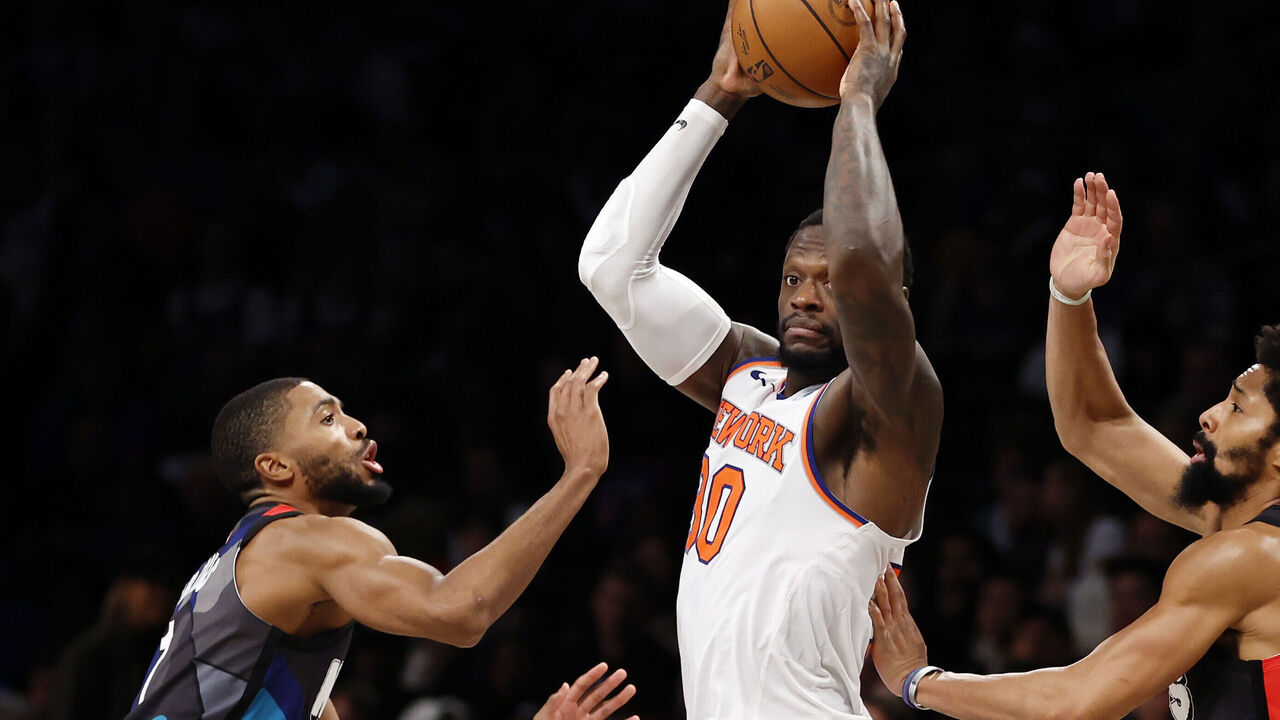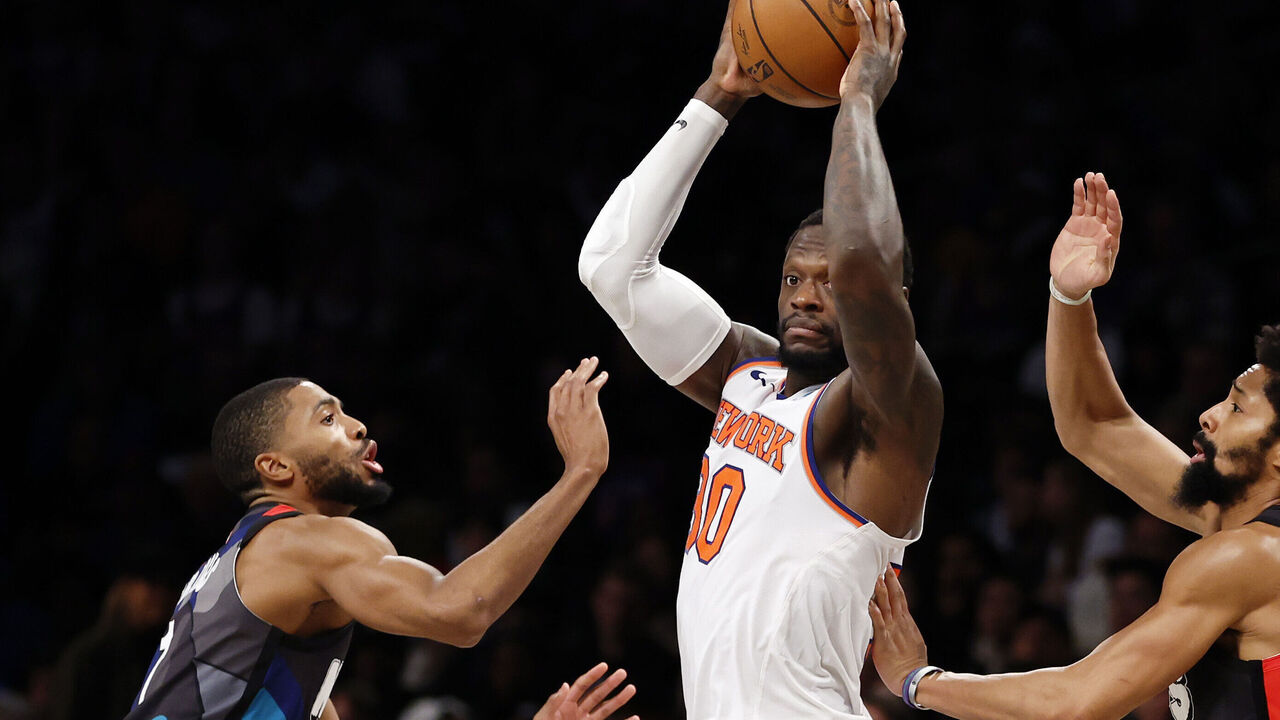Why shelling out for Bridges means Knicks must consider moving Randle
There’s a certain crossroads at which many fringe contenders find themselves where they have to decide whether they’re close enough to true contention to justify “losing” a trade based on raw asset value if it means vaulting themselves up another rung.
Beyond an evident desire to reassemble the 2017 Villanova Wildcats, that’s the calculation the New York Knicks’ front office made when it decided to send five first-round picks (four of their own unprotected firsts plus a protected Bucks pick in 2025), an unprotected first-round swap, and Bojan Bogdanovic to the Brooklyn Nets in exchange for Mikal Bridges.
The reason the Knicks wanted Bridges this badly – apart from his connection to fellow ‘Nova alums Jalen Brunson, Josh Hart, and Donte DiVincenzo – is easy to understand. He represents one of the most valuable commodities in the league: a long, versatile two-way wing who can slash, burn rubber in transition, bang movement threes, and thrive playing off of other creators, while also capably generating his own half-court offense as needed. It doesn’t tell you anything about the Knicks to say Bridges is a great fit there, because he’d be a great fit just about anywhere.
That plug-and-play skill set, coupled with a team-friendly contract that runs another two years, is why he garnered a superstar-level trade return despite never so much as sniffing All-Star consideration. The Knicks when even moderately healthy were very good last year, and adding Bridges to their existing group could make them the biggest challenger to the Celtics in the Eastern Conference over the next few years. The problem is that keeping that existing group together just became a lot more challenging.
As reasonable as Bridges’ contract is, his $23-million cap hit replaces Bogdanovic’s fully non-guaranteed deal. And unless the trade framework is restructured from what’s been reported, it will hard-cap New York at the first luxury-tax apron (approximately $178.7 million) because more money is coming in than going out. The Knicks agreed to this while the unrestricted free agencies of OG Anunoby and Isaiah Hartenstein – two of their most important 2023-24 contributors – hang over their heads. And as of now, they only have about $46 million of wiggle room below that hard cap to try to bring those guys back (and fill two additional roster spots).
Anunoby, in particular, needs to be retained in order for the front office’s aggressive new direction to pay off, especially considering the pieces that were surrendered to acquire him. Far from being redundant, he and Bridges would make for a terrific and complementary wing tandem capable of wreaking havoc and insulating Brunson on defense. If Anunoby walks, the Bridges trade goes from being a justifiable overpay to a potential disaster. And while Hartenstein is obviously a lesser priority, don’t sleep on the potential impact of losing a center whose rim protection, short-roll passing, floater-range touch, and monstrous offensive rebounding were huge components of New York’s success last season.
There aren’t really any savory options left on the menu given the aforementioned realities and variables, but the most palatable of those options – difficult as it might still be to swallow – would be moving off of Julius Randle.
That’s not something the Knicks would do lightly. Randle’s a great player who’s been instrumental to the team’s resurgence over the last few years. He’s frankly been one of the franchise’s most important figures over the last two decades. This isn’t even to say that he can’t fit well or thrive with the team as currently constructed. It’s just that with a financial crunch on the horizon, paying him and Anunoby something in the realm of $65 million a year to share an optimal position doesn’t feel like the best way to achieve roster balance.

Anunoby is best suited to playing the four offensively, and he’s clearly more than capable of manning that position (or even sliding up to the five) on defense. Brunson showed last season that he’s capable of shouldering an enormous creation burden, and the addition of Bridges will help alleviate that burden anyway. In 351 minutes with Brunson and Anunoby on court and Randle off last season, New York outscored opponents by 22.8 points per 100 possessions, according to PBP Stats.
Randle’s blunt-force interior scoring and rebounding prowess, coupled with strong frontcourt playmaking, have made him a three-time All-Star and two-time All-NBAer in his five years as a Knick. And yet, for the balance of his tenure in New York, the team has performed worse with him on the floor than on the bench. His defensive intensity and focus have fluctuated wildly, and he’s been prone to ball-stopping and poor shot selection on offense. The less said about his playoff misadventures, the better.
It’s worth noting that Randle tamped down a lot of his bad habits last season, especially after the Anunoby trade completed the Knicks’ starting five and they immediately ripped off a 12-2 run before Randle suffered a season-ending shoulder injury. Even so, the team almost certainly would’ve found itself in the East finals without him if not for subsequent injuries that either shelved or significantly hampered Brunson, Anunoby, and Mitchell Robinson.
Randle is a tough player to evaluate, as both an on-court contributor and a potential trade piece. What teams typically want in a modern-day four is high-end secondary rim protection and/or spacing – preferably both, but at least one of the two. For as good as he is in all kinds of other ways, Randle exists in this awkward power-forward purgatory where he doesn’t provide much of either. Lineups with him at center have never really worked defensively, but the floor can get cramped when he plays the four next to a traditional big.
Therein lies the challenge in trying to trade him. Randle should have a ton of value on the market based on his production and pedigree, but the difficulty of finding a clean fit elsewhere likely means he won’t command a return commensurate with his numbers and accolades. He’s obviously a much, much better player than John Collins, but living in that same in-between space is the reason Collins wound up being effectively salary-dumped a year ago.
To be clear: if the Knicks can’t do better than that in a Randle deal, they should hold onto him and let things play out. Turning the Bridges trade into one that costs them five first-rounders and their All-Star forward would be rough, both optically and practically. But if they can, say, bolster their backcourt depth and replenish some of the draft capital they shelled out to get Bridges, while re-signing both Anunoby and Hartenstein, it might be time to say goodbye to one of the best but most polarizing Knicks of the 21st century.
Joe Wolfond covers the NBA for theScore


